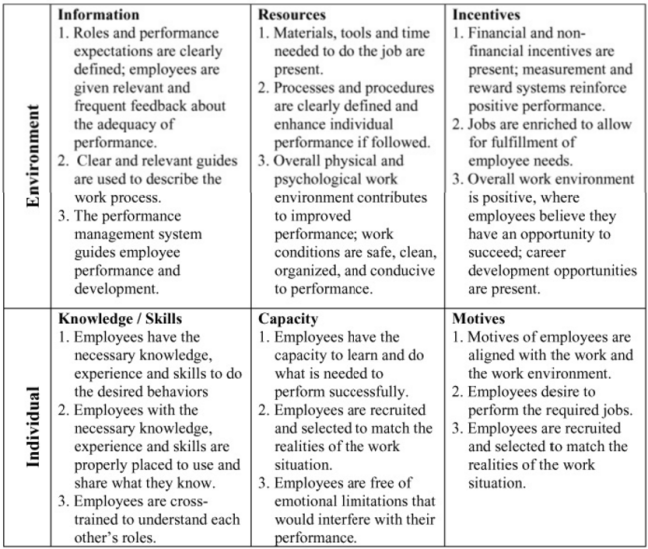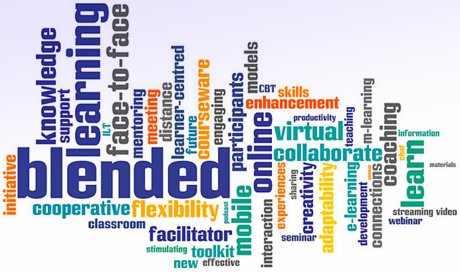 A while back I said that my next musings would be around Dr. Tom Gilbert and the Behaviour Engineering Model (B.E.M). but I keep running into other things that catch my attention! I will tie the BEM into the story at the end.
A while back I said that my next musings would be around Dr. Tom Gilbert and the Behaviour Engineering Model (B.E.M). but I keep running into other things that catch my attention! I will tie the BEM into the story at the end.
Last weekend we hosted a friend of my daughter’s who recently arrived at CFB Kingston to start his training as an Intelligence Operator (INT OP) in the Canadian Armed Forces (CAF). One of my first two projects as a Training Development Officer (TDO) was to convert the first forty hours of training for this course from Face-to-Face (F2F) to self-directed online learning. That was ten years ago… wow time flies!
2006 was “the year of the social network” (R. Macnus, 2006). Phones were getting smarter and the 3G network was here! Important to the CAF was the increased stability of its Learning Management System (LMS) “DNDLearn” which at the time was provided by Desire2Learn or D2L. Since then, the CAF has moved onto SABA and D2L created Brightspace. My point here is that with respect to Distance Learning (DL), the CAF was really at the beginning of a major shift when I was assigned the project.
When I took over the DL project, the school had already thought through a lot of the logistics and access issues. There was real (valid) concern that the learners might not have a computer, reliable Internet access or the support of their supervisors to commit the time required to complete the DL portion of the training. To address these issues, laptops, headsets and hard shipping cases were purchased to send to each student so everyone started at the same level with respect to technology. An instructor was available every day to support the learners. Learning contracts were developed that the instructor, the learner and the learner’s supervisor at the “home unit” had to sign.
This learning contract is really key to the story. The CAF is – understanding its culture – pretty particular about where it’s people are and what they are doing. The more junior you are, the more this applies! The staff at CFSMI were not about to let these new INT OPs run willy nilly all over the country unsupervised while they did this training! The instructional staff and I had some passionate debates about learner centricity and giving the learner responsibility. A tall order for an organization that is so control oriented.
Fast forward to last weekend. Matt and I were talking about his upcoming training and given my history with the initial attempt, I was naturally curious about what had changed! I wasn’t disappointed. The DL curriculum has expanded from 40 to 72 hours (9 training days) which is a pretty solid demonstration of success, but the change that really got me was that Matt has already headed back to Victoria while he completes his DL phase of training. The Chief Instructor’s directions were (in Matt’s words) “I don’t care where you do it, as long as you get it done on time and you don’t get hurt.” Quite a different contract from 2006.
Of course, logistics and access have changed quite a bit in the past ten years and the Defence Learning Network (DLN) has matured. More importantly, connectivity is not the issue it was and we are almost all connected. Internet access by individuals jumped from 67.9% in 2005 to 80.3% in 2009 (Statistics Canada, 2010). I couldn’t find more recent stats, but I think it is safe to say that access has surpassed 2009 levels and mobile technology keeps getting better.
So how does this story about learning relate to workplace performance? As noted in Expectations of the Workforce, there is a consensus amongst research and experts in the field of performance improvement that around 75-80 percent of the factors that influence performance are environmentally rather than individually based. The top row of Chevalier’s Improved Behaviour Engineering Model in Table 1 below helps focus the analyst’s attention here first.

Table 1: Updated BEM (Chevalier, 2003). Reprinted with permission.
The expectations “I don’t care where you do it, as long as you get it done on time and you don’t get hurt” are pretty clear! The maturity of the DNDLearn system ensures that guides, materials and tools are in place and support performance. The biggest change to me in this environment is the level of trust displayed by the leadership in allowing young Matt to really learn anywhere anytime, within the allotted timeframe of course. A truly incentivized environment!
My hat is off to the School of Military Intelligence and I trust Matt is enjoying being at home with friends and family while taking this first step in his journey to becoming an Intelligence Operator.
References
Macnus, R. (2006). 2006 Web Technology Trends. readwrite. Retrieved from http://readwrite.com/2006/12/11/2006_web_technology_trends, 09 Mar 2016.
Statistics Canada (2010). Internet use by individuals, by location of access, by province. Retrieved from http://www.statcan.gc.ca/tables-tableaux/sum-som/l01/cst01/comm36a-eng.htm 09 Mar 2016.
Chevalier, R. (2003). Updating the Behavior Engineering Model, Performance Improvement, 42(4), 8-13. Retrieved from www.aboutiwp.com


Nice bit of history Brett. A lot of ground has been covered in the last 10 years.
LikeLike
Thanks Mark. I can’t wait to see where we are in 2025!
LikeLike
Why do we pursue optimal performance in our work? Because our organizations or institutions will hopefully bestow upon us some prize for getting closer to the target aptly named “optimum.” Why is it aptly named? Because it starts with the same four letters as “optional” and “optics.” It is a word plagued with immeasurable uncertainty. Optimum, as a measure of performance, simply doesn’t exist. What we have instead is “the best we can do for now.” Do better than that and we recalibrate the measuring device. An old notion worthy of repetition goes something like this: the old best is the new unacceptable, and the new acceptable, which used to be considered optimum, is now just acceptable. Optimum performance, that illusive bastard, just slipped right out your fingers!
We aim for optimum performance because of the things that drive much of what we do for 8 hours a day, 5 days a week: incentive. Pay and recognition.
And what are managers becoming more and more proficient at? Undermining the motives (often the difference maker between good and great performance) of potential high performers by introducing incentives that are inconsistent and even repressive to the talents those performers bring to the team. The new mantra of management: be passionate about your work, but don’t let your passion infiltrate your work.
FOQ: How can we leverage Gilbert’s work to affect mega results?
LikeLike
Great response and follow on question John. You are right on the money with the observation that the measure of optimal performance changes over time. Individual ability, advances in technology and other environmental changes all play a role. Consider the fastest slap shot in hockey (https://ca.thesportscreen.com/fastest-slap-shot-ever-recorded/). 8 of the 10 players listed are still playing. Changes in how players are developed and technology in the flex of the stick certainly play a role. A great demonstration of why we should always be seeking ways to improve.
I am not sure I would characterize a manager who is undermining the motivation of employees through poor use of incentives as proficient. I hope most managers encourage passion in all quarters and reward those whose passion creates results!
MEGA results (https://en.wikipedia.org/wiki/Roger_Kaufman) are the results of an organizations efforts and their consequences for external clients and society. For me, Gilbert’s work, particularly the Leisurely Theorems (not just the BEM), give us a way to systematically examine the individuals and their performance environment. THAT information then can inform all five levels of Kaufman’s OEM as our analysis progresses.
How do you approach it??
LikeLike
Now that you’ve learned from the past – let’s talk about the future of Military Training! Looking forward to seeing you at this year’s ISPI Conference in Philly!
LikeLike
Thanks Rose! I wish I had the opportunity to attend this year but it isn’t in the cards.
LikeLike